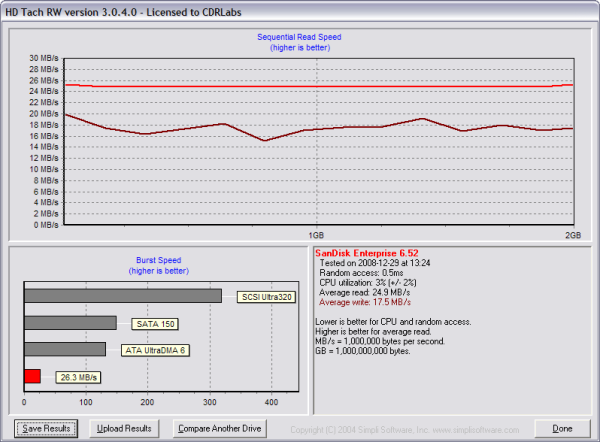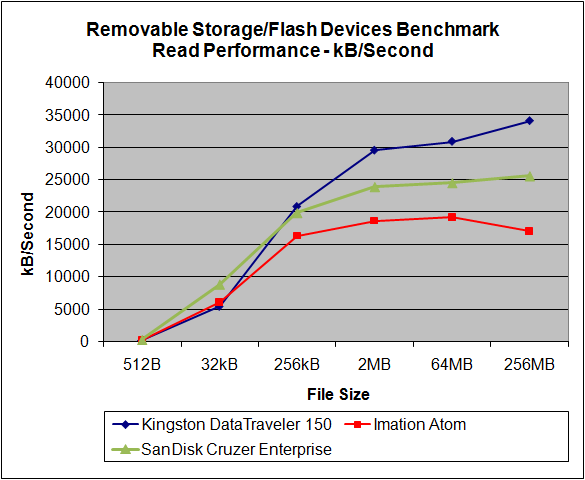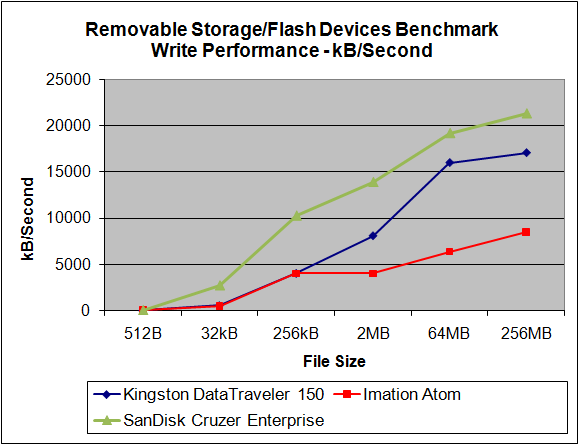Performance:
The test system used in this review was a Dell OptiPlex 755. The computer came equipped with an Intel Core 2 Duo E6750 2.66GHz CPU, 2GB of DDR2 800MHz memory, a Western Digital WD800JD 80GB SATA hard drive and an ATI Radeon HD 2400XT 256MB video card. For the operating system, I installed a fresh copy of Windows XP with Service Pack 3.
To test the performance of the Cruzer Enterprise, I ran a series of benchmarks using HD Tach RW 3.0.4.0 and SiSoftware Sandra Professional Business XII.SP2c. To get a feel for the "real world" performance, I also copied and pasted 500MB of random files and directories in Windows Explorer. For comparison, I've also included test results from the Kingston DataTraveler 150 and Imation Atom.
HD Tach RW 3.0.4.0:
Using HD Tach, we can benchmark a drive's read, write and burst speeds as well as its seek times and CPU usage.

The Cruzer Enterprise performed fairly well when tested with HD Tach. Looking at the screenshot above, you can see that the drive had average read and write speeds of 24.9 MB/s and 17.5 MB/s, respectively, as well as a burst speed of 26.3 MB/s.
SiSoft Sandra File System Benchmark:
While I am not a big fan of SiSoftware Sandra's optical drive benchmarks, it is a great tool if you want to test a system's performance quickly and easily. One of Sandra's more useful tests is the File System benchmark. This benchmark gives each drive an overall score, or "Drive Index," based on the results of its read and write tests.
| SanDisk Cruzer Enterprise |
Kingston DataTraveler 150 |
Imation Atom | |
| Drive Index: | 22.63 MB/s | 28.36 MB/s | 16.63 MB/s |
| Buffered Read: | 24.62 MB/s | 31.54 MB/s | 19.22 MB/s |
| Sequential Read: | 24.69 MB/s | 32.46 MB/s | 19.31 MB/s |
| Random Read: | 24.68 MB/s | 32.42 MB/s | 19.24 MB/s |
| Buffered Write: | 5.21 MB/s | 235 kB/s | 470 kB/s |
| Sequential Write: | 19.38 MB/s | 17.32 MB/s | 7.55 MB/s |
| Random Write: | 6.99 MB/s | 4.04 MB/s | 3.75 MB/s |
The Cruzer Enterprise performed very well when doing buffered, sequential and random writes. While faster than the Imation Atom, the drive lagged behind the Kingston DT150 in the read tests.
SiSoftware Sandra Removable Storage/Flash Devices Benchmark:
Designed with removable storage and flash devices in mind, this benchmark tests a drive's read, write and delete performance using six different file sizes (512 Bytes, 32kB, 256kB, 2MB, 64MB and 256MB). The results are then given in both operations per minute and the corresponding net transfer rate in kB/second. This benchmark also computes an "Endurance Factor," representing the wear and life expectancy of flash devices.

| SanDisk Cruzer Enterprise |
Kingston DataTraveler 150 |
Imation Atom | |
| 512B Read: | 248 kB/s | 146 kB/s | 196 kB/s |
| 32kB Read: | 8820 kB/s | 5430 kB/s | 6050 kB/s |
| 256kB Read: | 19890 kB/s | 20870 kB/s | 16320 kB/s |
| 2MB Read: | 23930 kB/s | 29570 kB/s | 18630 kB/s |
| 64MB Read: | 24530 kB/s | 30930 kB/s | 19200 kB/s |
| 256MB Read: | 25600 kB/s | 34130 kB/s | 17070 kB/s |
While the Cruzer Enterprise was the fastest of the three drives when reading 512B and 32kB files, it wasn't able to keep up with DT150 when reading larger files.

| SanDisk Cruzer Enterprise |
Kingston DataTraveler 150 |
Imation Atom | |
| 512B Write: | 42 kB/s | 10 kB/s | 15 kB/s |
| 32kB Write: | 2710 kB/s | 547 kB/s | 494 kB/s |
| 256kB Write: | 10270 kB/s | 4030 kB/s | 4020 kB/s |
| 2MB Write: | 13900 kB/s | 8100 kB/s | 4000 kB/s |
| 64MB Write: | 19200 kB/s | 16000 kB/s | 6400 kB/s |
| 256MB Write: | 21330 kB/s | 17070 kB/s | 8530 kB/s |
The Cruzer Enterprise performed very well when writing. The drive lead the way when writing both small and large files, reaching a maximum speed of 21,330 kB/s.

| SanDisk Cruzer Enterprise |
Kingston DataTraveler 150 |
Imation Atom | |
| Combined Index: | 5979 | 1940 | 2813 |
| 512B Files Test: | 9656 | 2691 | 4082 |
| 32kB Files Test: | 8026 | 2304 | 3507 |
| 256kB Files Test: | 3095 | 1789 | 1714 |
| 2MB Files Test: | 503 | 427 | 240 |
| 64MB Files Test: | 18 | 20 | 10 |
| 256MB Files Test: | 5 | 5 | 2 |
As I mentioned above, Sandra also expresses performance in operations per minute. To keep things simple, I've limited the results to the combined index and the total number of read/write/delete operations for each file size.
The Cruzer Enterprise did very well in this test. The drive not only had the highest combined index, it completed an impressive number of operations with 512B, 32kB, 256kB and 2MB files.
| SanDisk Cruzer Enterprise |
Kingston DataTraveler 150 |
Imation Atom | |
| Endurance Factor: | 8.60 | 15.00 | 17.80 |
The Endurance Factor represents the wear and life expectancy of a flash device. According to SiSoft, this number is computed by "dividing the average performance (normal condition, i.e. sequential write) to the lowest performance (high-stress condition, i.e. same block re-write)."
"Real World" Benchmark:
To test the "real world" performance of Kingston's new flash drive, I copied and pasted 500 MB worth of randomly generated files and directories. All of the files are between 10 bytes and 32MB in size and no more than four directories deep.
| SanDisk Cruzer Enterprise |
Kingston DataTraveler 150 |
Imation Atom | |
| Write: | 1:02 | 2:31 | 2:28 |
| Read: | 31 seconds | 15 seconds | 20 seconds |
The Cruzer Enterprise yielded some mixed results in this test. While the fastest of the three drives when writing, it was 16 seconds slower than the Kingston DT150 when reading back our test data.
Conclusion:
The SanDisk Cruzer Enterprise is an excellent solution for the security conscious consumer or the corporate IT department looking to keep sensitive data out of the wrong hands. Rather than rely upon users to secure files, the drive stores all data in a hardware-encrypted, password-protected partition. The Cruzer Enterprise also supports both Macintosh and Windows computers and can be centrally managed using SanDisk's CMC software. Thankfully, this extra security didn't have much of an impact on performance. While not as fast as some other flash drives when reading, the Cruzer Enterprise had no problems holding its own in our tests.
While few and far between, the Cruzer Enterprise does have a few low points. The drive's cap cannot be placed on the opposite end when in use, which makes it easy to misplace. And, like most secure flash drives, the Cruzer Enterprise commands a hefty price tag. Unless you're serious about security, it's going to be hard to justify paying more than $70 for a 2GB flash drive, when you can get one with more storage for considerably less.
The Cruzer Enterprise is available now in 1GB, 2GB, 4GB and 8GB capacities. Suggested retail prices range from $75 to $333 depending on the size. However, the drive can be picked up for considerably less through some of the vendors on PriceGrabber.
Highs:
- Mandatory security on all files
- Hardware based 256-bit AES encryption
- Includes "lockdown" mode for increased security
- Fast transfer speeds
- Compatible with Windows 2000/XP/Vista and Mac OS X
- Can be centrally managed (using SanDisk CMC software)
- Two year warranty
Lows:
- Cap cannot be placed on opposite end of drive
- Expensive

